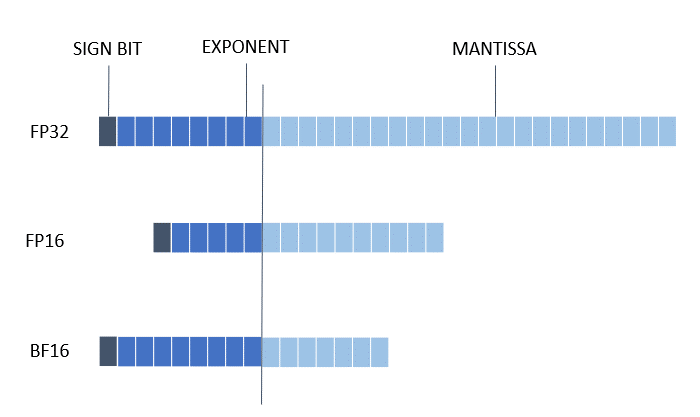PyTorch Mixed Precision
Introduction
The recent growth of Deep Learning has driven the development of more complex models that require significantly more compute and memory capabilities. Several low precision numeric formats have been proposed to address the problem. Google’s bfloat16 and the FP16: IEEE half-precision format are two of the most widely used sixteen bit formats. Mixed precision training and inference using low precision formats have been developed to reduce compute and bandwidth requirements.
The 3rd Gen Intel® Xeon® Scalable processor (codenamed Cooper Lake), featuring Intel® Deep Learning Boost, is the first general-purpose x86 CPU to support the bfloat16 format. Specifically, three new bfloat16 instructions are added as a part of the AVX512_BF16 extension within Intel Deep Learning Boost: VCVTNE2PS2BF16, VCVTNEPS2BF16, and VDPBF16PS. The first two instructions allow converting to and from bfloat16 data type, while the last one performs a dot product of bfloat16 pairs. Further details can be found in the Hardware Numerics Document published by Intel.
The 4th Gen Intel® Xeon® Scalable processor supports FP16 instruction set architecture (ISA) for Intel® Advanced Vector Extensions 512 (Intel® AVX-512). The new ISA supports a wide range of general-purpose numeric operations for 16-bit half-precision IEEE-754 floating-point and complements the existing 32-bit and 64-bit floating-point instructions already available in the Intel Xeon processor based products. Further details can be found in the Intel AVX512 FP16 Guide published by Intel.
The latest Intel Xeon processors deliver flexibility of Intel Advanced Matrix Extensions (Intel AMX) ,an accelerator that improves the performance of deep learning(DL) training and inference, making it ideal for workloads like NLP, recommender systems, and image recognition. Developers can code AI functionality to take advantage of the Intel AMX instruction set, and they can code non-AI functionality to use the processor instruction set architecture (ISA). Intel has integrated the Intel® oneAPI Deep Neural Network Library (oneDNN), its oneAPI DL engine, into Pytorch. Further details can be found in the Intel AMX Document published by Intel.

Mixed Precision Support Matrix
| Framework | Backend | Backend Library | Backend Value | Support Device(cpu as default) | Support BF16 | Support FP16 |
|---|---|---|---|---|---|---|
| PyTorch | FX | FBGEMM | "default" | cpu | ✔ | ✔ |
Hardware and Software requests for BF16
PyTorch
Hardware: CPU supports
avx512_bf16instruction set.Software: torch >= 1.11.0.
Hardware and Software requests for FP16
PyTorch
Hardware: CPU supports
avx512_fp16instruction set.Software: torch >= 1.11.0.
Note: To run FP16 on Intel-AMX, please set the environment variable
ONEDNN_MAX_CPU_ISA:export ONEDNN_MAX_CPU_ISA=AVX512_CORE_AMX_FP16
Accuracy-driven mixed precision
BF16/FP16 conversion may lead to accuracy drop. Intel® Neural Compressor provides an accuracy-driven tuning function to reduce accuracy loss,
which could fallback converted ops to FP32, if set in config, to get better accuracy. To enable this function, users only to provide
eval_fn and eval_args for autotune.
To be noticed, IPEX backend doesn’t support accuracy-driven mixed precision.
Get Started with autotune API
To get a bf16/fp16 model, users can use the autotune interface with MixedPrecisionConfig as follows.
BF16:
from neural_compressor.torch.quantization import MixedPrecisionConfig, TuningConfig, autotune
def eval_acc_fn(model):
......
return acc
# modules might be fallback to fp32 to get better accuracy
custom_tune_config = TuningConfig(config_set=[MixedPrecisionConfig(dtype=["bf16", "fp32"])], max_trials=3)
best_model = autotune(model=build_torch_model(), tune_config=custom_tune_config, eval_fn=eval_acc_fn)
FP16:
from neural_compressor.torch.quantization import MixedPrecisionConfig, TuningConfig, autotune
def eval_acc_fn(model):
......
return acc
# modules might be fallback to fp32 to get better accuracy
custom_tune_config = TuningConfig(config_set=[MixedPrecisionConfig(dtype=["fp16", "fp32"])], max_trials=3)
best_model = autotune(model=build_torch_model(), tune_config=custom_tune_config, eval_fn=eval_acc_fn)
Examples
Users can also refer to examples on how to quantize a model with Mixed Precision.